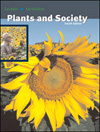 |
1 |  | 
1. The trout lily is one _______ of understory plants in an oak-hickory forest _______ in southern New England. |
|  | A) | a. niche, habitat |
|  | B) | b. biosphere, community |
|  | C) | c. population, community |
|  | D) | d. population, niche |
|  | E) | e. community, biosphere |
 |
 |
2 |  | 
2. The transfer and concentration of a toxic material along a food chain is known as _________. |
|  | A) | a. Resource partitioning |
|  | B) | b. Biological magnification |
|  | C) | c. Ecological pyramid |
|  | D) | d. Green house effect |
|  | E) | e. None of the above |
 |
 |
3 |  | 
3. In a typical grazing food chain, _______are eaten by _______. |
|  | A) | a. autotrophs, heterotrophs |
|  | B) | b. primary consumers, secondary consumers |
|  | C) | c. producers, consumers |
|  | D) | d. all of the above |
|  | E) | e. none of the above |
 |
 |
4 |  | 
4. Most ecological pyramids generally have a higher number of organisms at the top of the pyramid than at the base of the pyramid. |
|  | A) | True |
|  | B) | False |
 |
 |
5 |  | 
5. DDT, PCBs, and mercury are all examples of toxic substances that may be transferred and concentrated along a food chain. |
|  | A) | True |
|  | B) | False |
 |
 |
6 |  | 
6. Which of the following is an example of an ecological credit as described in the Kyoto Protocol? |
|  | A) | a. protecting sinks such as forests |
|  | B) | b. aiding a developing nation with an emission-reducing project |
|  | C) | c. building a nonpolluting hydroelectric dam |
|  | D) | d. all of the above |
|  | E) | e. a and c are correct |
 |
 |
7 |  | 
7. The return of vegetation following a volcanic explosion is an example of ______. |
|  | A) | a. climactic succession |
|  | B) | b. secondary succession |
|  | C) | c. primary succession |
|  | D) | d. all of the above |
|  | E) | e. only a and b |
 |
 |
8 |  | 
8. In which biome would you find xerophytic plants? |
|  | A) | a. desert |
|  | B) | b. tropical rain forest |
|  | C) | c. temperate deciduous forest |
|  | D) | d. grasslands |
|  | E) | e. pine forests |
 |
 |
9 |  | 
9. Which plant has been nicknamed the botanical whale because of the usefulness of its seed oil? |
|  | A) | a. kenaf |
|  | B) | b. jojoba |
|  | C) | c. guayule |
|  | D) | d. hickory |
|  | E) | e. chestnut |
 |
 |
10 |  | 
10. Many shrubs of the chaparral have sclerophyllous leaves, which means they are thin and papery and cannot withstand freezing temperatures. |
|  | A) | True |
|  | B) | False |
 |
 |
11 |  | 
11. Which of the following is an example of grassland biomes? |
|  | A) | a. chaparral |
|  | B) | b. the savanna |
|  | C) | c. the tundra |
|  | D) | d. all of the above |
|  | E) | e. both b and c |
 |
 |
12 |  | 
12. Which of the following is NOT a characteristic of the boreal forest? |
|  | A) | a. It has a four-month growing season. |
|  | B) | b. The soil is relatively infertile and acidic. |
|  | C) | c. There is a permanently frozen layer of soil under the topsoil. |
|  | D) | d. Forest litter decays slowly due to cool temperatures. |
|  | E) | e. Many migratory species of birds temporarily inhabit. |
 |
 |
13 |  | 
13. A tropical rain forest is characterized by broadleaf evergreen trees, an abundance of lianas and epiphytes, and a very high rate of decay. |
|  | A) | True |
|  | B) | False |
 |
 |
14 |  | 
14. Early Native Americans played public games with rubber balls made of latex extracted primarily from the _______ tree. |
|  | A) | a. Ipomea alba |
|  | B) | b. Castilla elastica |
|  | C) | c. Hevea brasiliensis |
|  | D) | d. Manilkara zapota |
|  | E) | e. None of the above |
 |
 |
15 |  | 
15. The advantage of the strip-cutting method of timber harvesting is that every part of the tree is harvested so that there is no waste of the harvested material. |
|  | A) | True |
|  | B) | False |
 |
 |
16 |  | 
16. In which timber harvesting method are trunks cut at ground level and the stumps allowed to sprout multiple stems? |
|  | A) | a. selective cutting |
|  | B) | b. coppice method |
|  | C) | c. creaming |
|  | D) | d. shelterwood method |
|  | E) | e. whole-tree harvest |
 |



 2006 McGraw-Hill Higher Education
2006 McGraw-Hill Higher Education

 2006 McGraw-Hill Higher Education
2006 McGraw-Hill Higher Education